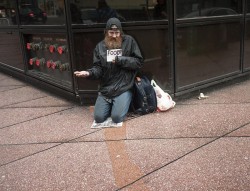John Denniston is a retired newspaper photographer who still has a compelling desire to take interesting photographs. His current project is photographing reality, not as a way to determine truth, but as an opposite to myth. A premiss for these photographs is that photography is less about being creative than it is about recognizing the significance of our surroundings and making records.
Peripheral Vision Series: Street photography in Vancouver.
Photographers are very familiar with the phenomena of driving along a street, seeing a terrific picture through a side window, stopping the car, walking back to the exact same spot and discovering that the picture, or at least the angle or the objects which created the frame for the image in their mind, just isn’t there anymore.
My theory is that because our eyes see just a narrow patch of the scene before us what the photographer actually saw framing his picture was recovered memory from peripheral vision. This memory is delayed and therefore out of sync with what came from his eyes so the reality, once movement stops, is different. Most of the image had been filled in by memory.
So what does this little bit of speculative thinking have to do with my pictures in Photosynthesis 2013 which were made with a point and shoot camera held about chest high, not looking through the viewfinder, as I walked along streets in Vancouver. It’s the moment of capture. The subjects were framed in my mind as they walked towards me but the shutter was pushed as they passed by, the decisive moment happening in my peripheral vision. This fits with another characteristic of pedestrians walking the streets of a big city; they avoid eye contact with others. They look but don’t want to be caught looking. They look from the corner of their eye. So photographing from the side helps me photograph the street as it’s actually seen, what the people wear, how they walk, how they react to other pedestrians, as they are, not how they want to be seen and how they are seen by others, peripherally. So there is actually reason in the method’s madness although true street photographers might have issues with the technique and Cartier-Bresson would be apoplectic but he’s dead so who really cares.
The pictures aren’t for sale and are displayed to promote debate. Their ultimate destination is possibly the Vancouver Archives. The pictures document the street. They’re not art.
John Denniston, August 2013





















